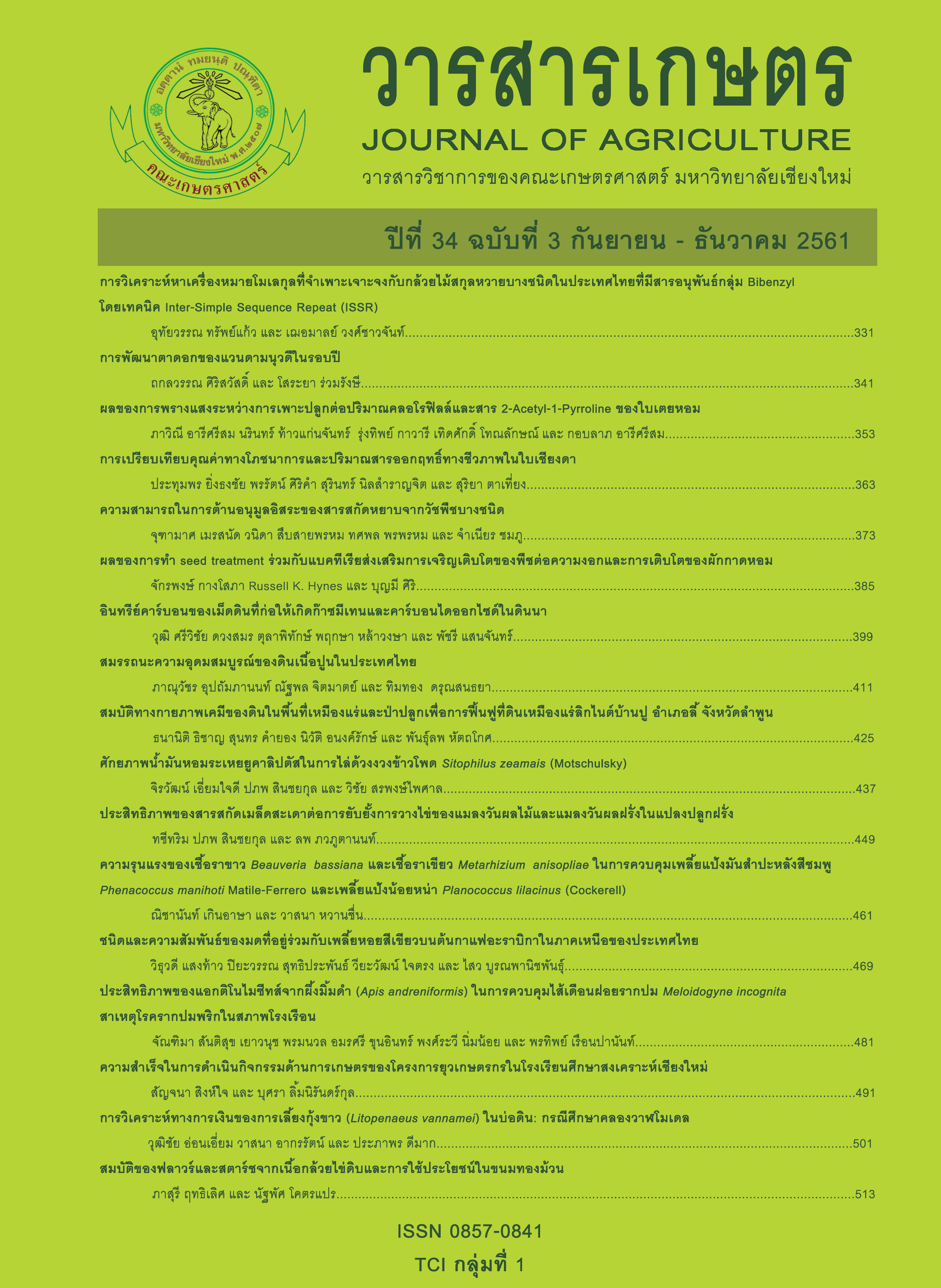ประสิทธิภาพของแอกติโนไมซีทส์จากผึ้งมิ้มดำ (<I>Apis andreniformis</I>) ในการควบคุมไส้เดือนฝอยรากปม <I>Meloidogyne incognita</I> สาเหตุโรครากปมพริกในสภาพโรงเรือน
Main Article Content
บทคัดย่อ
การทดสอบแอกติโนไมซีทส์ที่แยกได้จากลำไส้ผึ้งมิ้มดำ (Apis andreniformis) จำนวน 33 ไอโซเลท ในการควบคุมไส้เดือนฝอยรากปม Meloidogyne incognita ในระดับห้องปฏิบัติการพบว่าแอกติโนไมซีทส์จำนวน 11 ไอโซเลทมีความสามารถในการลดอัตราการฟักของไข่และเพิ่มอัตราการตายของตัวอ่อนระยะที่ 2 ซึ่งเป็นระยะเข้าทำลายของไส้เดือนฝอยรากปม M. incognita ไอโซเลท A038 ลดอัตราการฟักไข่ได้มากที่สุดถึงร้อยละ 92.04 และไอโซเลท A027 เพิ่มอัตราการตายของตัวอ่อนระยะที่ 2 มากที่สุดถึงร้อยละ 51.31 เมื่อเทียบกับชุดควบคุม จากนั้นนำเชื้อแอกติโนไมซีทส์ทั้ง 11 ไอโซเลท มาทดสอบผลของการฟักของไข่ในกลุ่มไข่ พบว่าแอกติโนไมซีทส์ไอโซเลท A032 และ A031 สามารถลดอัตราการฟักของกลุ่มไข่มากที่สุดถึงร้อยละ 69.51 และ 69.43 ตามลำดับ เมื่อนำเชื้อแอกติโนไมซีทส์ทั้ง 11 ไอโซเลทมาทดสอบการควบคุมโรครากปมของพริกในระดับโรงเรือนพบว่าเชื้อแอกติโนไมซีทส์ไอโซเลท A032 สามารถลดการเกิดปมของรากพริกสูงถึงร้อยละ 50 นอกจากนี้ยังทำให้น้ำหนักแห้งของพริกเพิ่มขึ้นอีกด้วย
Article Details
เอกสารอ้างอิง
กมล เลิศรัตน์. 2555. การผลิต การปลูก การแปรรูป และการตลาดของพริกและผลิตภัณฑ์พริกในประเทศไทย. (ระบบออนไลน์). แหล่งข้อมูล: http://www.trf.or.th/index.php?option=com_content&view=article&id=186 (1 สิงหาคม 2560).
จำเนียร ชมพู อมรศรี ขุนอินทร์ อภิรัฐ บัณฑิต และ ทศพล พรพรหม. 2561. ผลของอัลลีโลพาทีในวัชพืชที่ปลูกร่วมกับมะเขือเทศต่อการเข้าทำลายของไส้เดือนฝอยรากปม (Meloidogyne spp.). วารสารเกษตร 34(1): 55-56.
นุชนารถ ตั้งจิตสมคิด. 2550. การควบคุมโรครากปมในพริก. กรมวิชาการเกษตร, กรุงเทพฯ.
นุชนารถ ตั้งจิตสมคิด วราภรณ์ ประกอบ และ สิริกุล วะสี. 2552. การคัดเลือกและประเมินพันธุ์พริกต้านทานไส้เดือนฝอยรากปม. หน้า 331-341. ใน: รายงานการประชุมวิชาการอารักขาพืชแห่งชาติ ครั้งที่ 9. วันที่ 24-26 พฤศจิกายน 2552. โรงแรมสุนีย์แกรนด์ จ. อุบลราชธานี.
รัติกาล ยุทธศิลป์ เพชรรัตน์ ธรรมเบญจพล และ อนันต์ หิรัญสาลี. 2554. ศักยภาพของเชื้อ Streptomyces-PR87 ปฏิปักษ์ และวิธีการใช้สำหรับควบคุมไส้เดือนฝอยรากปม (Meloidogyne incognita) ในสภาพโรงเรือนปลูกพืชทดลอง. แก่นเกษตร 41(1) พิเศษ: 213-219.
อภิรัฐ บัณฑิต และ ทศพล พรพรหม. 2560. การประเมินคุณลักษณะทางอัลลีโลพาธีจากหญ้าโขย่งต่อการยับยั้งการเติบโตของวัชพืชในสภาพแปลง. วารสารเกษตร 33(2): 193-202.
Bird, A.F. and J. Bird. 2012. The Structure of Nematodes. 2nd ed. Academic Press, San Diego. 317 p.
Dong, L.Q. and K.Q. Zhang. 2006. Microbial control of plant-parasitic nematodes: a five party interaction. Plant and Soil 288(1-2): 31-45.
Eisenback, J.D., H. Hirschmann, J.N. Sasser and A.C. Triantaphyllou. 1981. A guide to the four most common species of root-knot nematodes (Meloidogyne spp.), with a pictorial key. North Carolina State University, Releigh, North Carolina. 48 p.
Faske, T.R. and J.L. Starr. 2006. Cotton root protection from plant-parasitic nematodes by abamectin-treated seed. Journal of Nematology 39(1): 27-30.
Inglis, G.D., S. Lynne and M. S. Goette. 1993. Aerobic microorganisms associated with alfalfa leafcutter bees Megachile rotundata. Microbial Ecology Journal 26: 125-143.
Mercer, C.F., D.R. Greenwood and J.L. Grant. 1992. Effect of plant and microbial chitinases on the eggs and juveniles of Meloidogyne hapla Chitwood. Nematologica 38: 227-236.
Na, J., H. Xue, W.J. Li, X.Y. Wang, Q. Liu, S.S. Liu, J.J. Zhao and H. Jian. 2017. Field evaluation of Streptomyces rubrogriseus HDZ-9-47 for biocontrolof Meloidogyne incognita on tomato. Journal of Integrative Agriculture 16(6): 1347-1357.
Nimnoi, P., N. Pongsilp and P. Ruanpanun. 2017. Monitoring the efficiency of Streptomyces galilaeus strain KPS C004 against root knot disease and the promotion of plant growth in the plant-parasitic nematode infested soils. Biological Control 114: 158-166.
Palmieri, G., C. Bianco, G. Cennamo, P. Giardina, G. Marino, M. Monti and G.I. Sannia. 2001. Purification, characterization, and functional role of a novel extracellular protease from Pleurotus ostreatus. Applied and Environmental Microbiology 6: 2754-2759.
Promnuan, Y., T. Kudo and P. Chantawannakul. 2009. Actinomycetes isolated from beehives in Thailand. World Journal of Microbiology and Biotechnology 25: 1685-1689.
Ruanpanun, P. and C. Chamswarng. 2016. Potential of actinomycetes isolated from earthworm casting in controlling root-knot nematode Meloidogyne incognita. Journal of General Plant Pathology 82: 43-50.
Ruanpanun, P., H. Laatsch, N. Tangchitsomkid and S. Lumyoug. 2011. Nematicidal activity of fervenulin isolated from a nematicidal actinomycete, Streptomyces sp. CMU-MH021, on Meloidogyne incognita. World Journal of Microbiology and Biotechnology 27: 1373-1380.
Ruanpanun, P., N. Tangchitsomkid, K.D. Hyde and S. Lumyong. 2010. Actinomycetes and fungi isolated from plant-parasitic nematode infested soils: screening of the effective biocontrol potential, indole-3-acetic acid and siderophore production. World Journal of Microbiology and Biotechnology 26: 1569-1578.
Sun, M.H., L. Gao, Y.X. Shi, B.J. Li and X.Z. Liu. 2006. Fungi and actinomycetes associated with Meloidogyne spp. eggs and females in China and their biocontrol potential. Journal of Invertebrate Pathology 93: 22-28.
Tarkka, M.T. and R. Hampp. 2008. Secondary metabolites of soil Streptomycetes in biotic interactions. pp. 107-126. In: P. Karlovsky (ed.). Secondary Metabolites in Soil Ecology. Springer, Berlin.
Tarkka, M.T., N.A. Lehr, R. Hampp and S.D. Schrey. 2008. Plant behavior upon contact with Streptomycetes. Plant Signaling & Behavior 3: 917-919.


